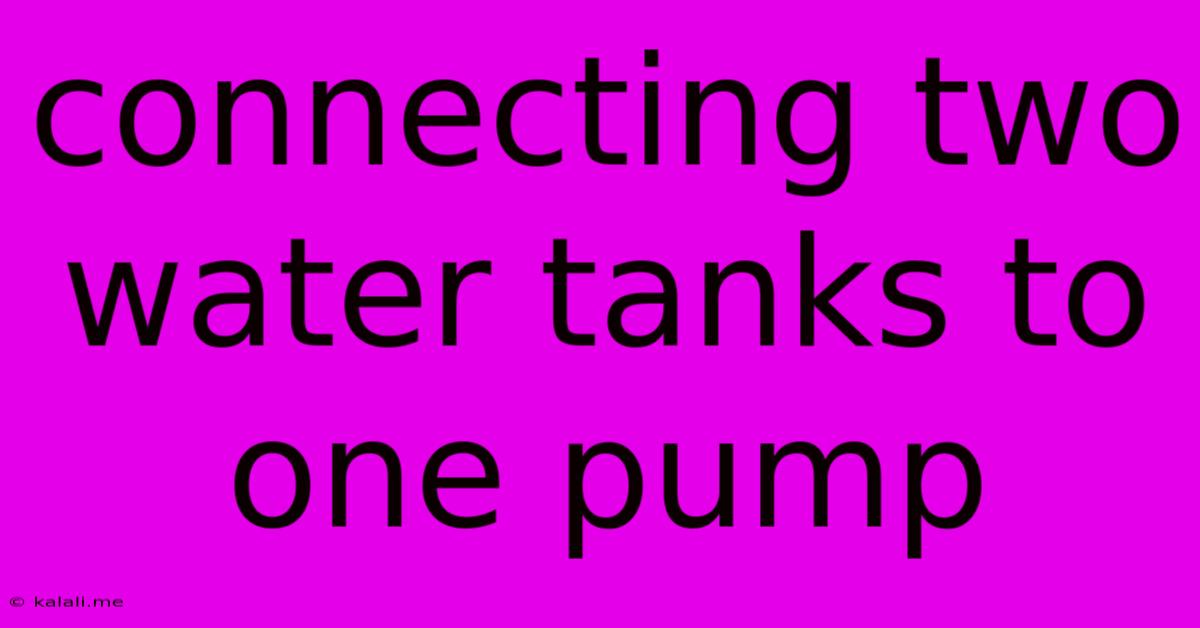Connecting Two Water Tanks To One Pump
Kalali
Jun 04, 2025 · 4 min read

Table of Contents
Connecting Two Water Tanks to One Pump: A Comprehensive Guide
Connecting two water tanks to a single pump can be a highly efficient solution for various applications, from home irrigation systems to larger-scale industrial needs. This guide will walk you through the process, covering different configurations, essential components, and crucial safety considerations. This detailed explanation will ensure you understand the plumbing and electrical aspects for a safe and effective setup.
Understanding Different Configurations
There are two primary methods for connecting two water tanks to a single pump:
1. Simultaneous Pumping:
This setup involves the pump drawing water from both tanks concurrently. This is ideal when you need a consistent and high volume of water supply. However, it requires a pump with sufficient capacity to handle the combined water demand from both tanks. This often necessitates a more powerful and potentially more expensive pump. It also demands careful consideration of water levels in both tanks to prevent one from being emptied completely before the other.
2. Sequential Pumping (Alternating):
In this method, the pump draws water from one tank until it reaches a predetermined low level, then automatically switches to the second tank. This approach is more cost-effective as it often allows for the use of a smaller, less powerful pump. It's particularly suitable for situations where consistent high-volume water flow isn't critical. This configuration often requires additional control systems like float switches or level sensors.
Essential Components:
Regardless of the chosen configuration, several key components are necessary:
-
Water Pump: The heart of the system, the pump's capacity (in gallons per minute or liters per minute) and head pressure (the vertical distance it can lift water) must be carefully selected to meet your needs. Consider the combined volume and elevation differences between the tanks and the point of water usage.
-
Pipes and Fittings: High-quality, durable pipes are essential to withstand pressure and prevent leaks. Choose appropriate fittings to ensure secure connections and a watertight system. The pipe diameter will influence the flow rate.
-
Check Valves: These prevent backflow from one tank to the other when the pump is not operating. They are crucial for maintaining the correct water flow direction within the system.
-
Control System (for Sequential Pumping): For sequential pumping, you'll need a control system. This could involve float switches (simple and cost-effective), level sensors (more precise), or even a programmable logic controller (PLC) for complex scenarios.
-
Filters: Installing filters helps prevent debris from damaging the pump and clogging the system. This extends the lifespan of your pump and ensures cleaner water.
Steps for Installation (General):
These steps offer a general overview. The specifics will vary depending on your chosen configuration and components. Always consult a professional plumber for complex installations.
-
Planning and Design: Carefully plan the layout of your system, considering the location of tanks, pump, and water usage points. Measure distances and elevation changes accurately.
-
Pipe Installation: Install the pipes connecting the tanks to the pump, ensuring secure and leak-free joints. Maintain appropriate slopes to facilitate water flow.
-
Pump Installation: Securely mount the pump in a stable location, ensuring easy access for maintenance. Follow the manufacturer's instructions for installation.
-
Check Valve Installation: Install check valves on each tank's inlet line to prevent backflow.
-
Filter Installation: Install filters on the suction side of the pump to protect it from debris.
-
Control System Installation (if applicable): If using sequential pumping, install and configure the control system according to the manufacturer's instructions.
-
Testing and Adjustments: After installation, thoroughly test the system to ensure proper operation. Make adjustments as needed to optimize flow and pressure.
Safety Considerations:
-
Electrical Safety: Ensure proper grounding and circuit protection for the pump's electrical connections. Avoid contact with water while working with electrical components.
-
Water Pressure: Monitor water pressure to avoid exceeding the pump's maximum pressure rating.
-
Regular Maintenance: Regularly inspect the system for leaks, clogs, and wear and tear. This ensures optimal performance and extends the lifespan of the components.
Connecting two water tanks to one pump can be a valuable undertaking. By carefully planning, selecting the right components, and adhering to safety precautions, you can create an efficient and reliable water supply system. Remember to always prioritize safety and consider consulting a professional plumber for assistance if needed.
Latest Posts
Latest Posts
-
Can You Put A Portable Hole In A Handy Haversack
Jun 06, 2025
-
Why Did Militarys Stop Using Armor
Jun 06, 2025
-
How To Make Your Alarm Loud
Jun 06, 2025
-
Did Judas Know Jesus Would Be Killed
Jun 06, 2025
-
Find A Basis Of The Orthogonal Complement
Jun 06, 2025
Related Post
Thank you for visiting our website which covers about Connecting Two Water Tanks To One Pump . We hope the information provided has been useful to you. Feel free to contact us if you have any questions or need further assistance. See you next time and don't miss to bookmark.